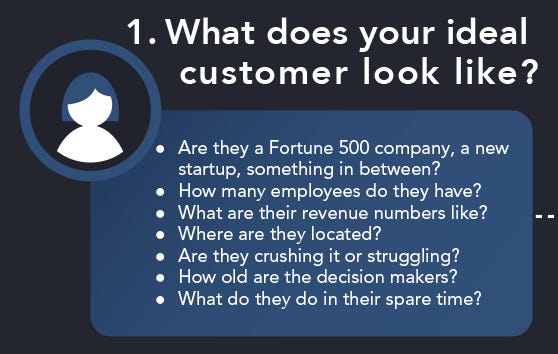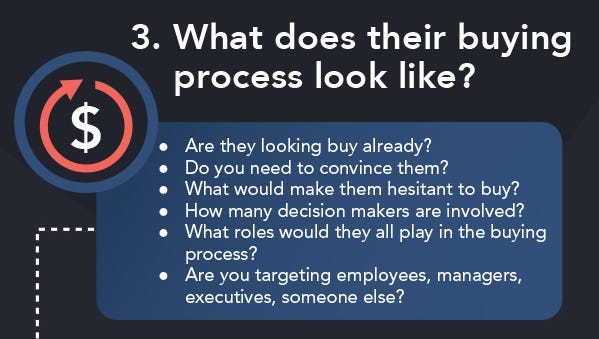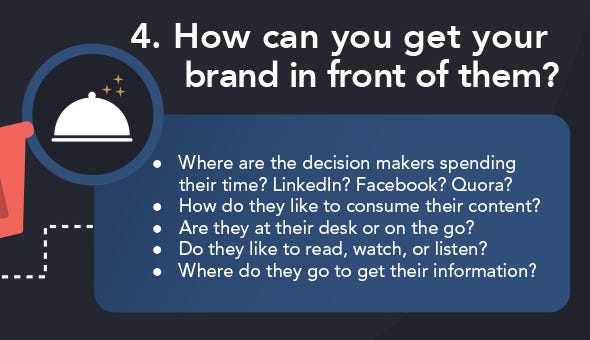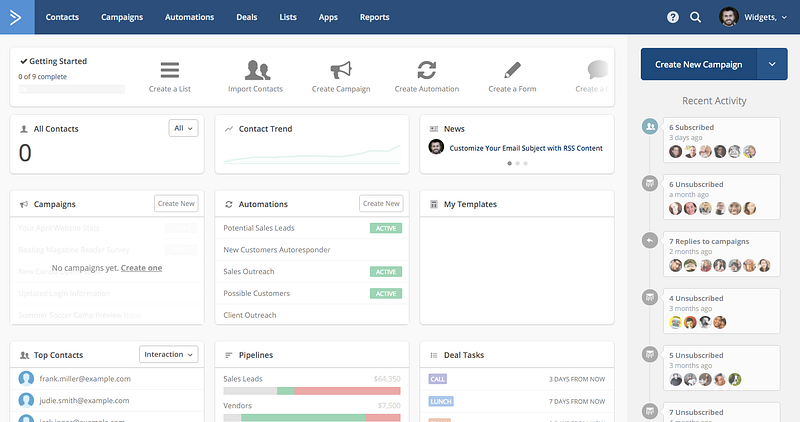Article's Content
In this post, I’m going to share with you my 3-step process for identifying your target audience and creating data-backed marketing personas.
Let’s get started! 🚀
When it comes to B2B marketing, understanding who you’re talking to (and what they’re thinking) is key to getting the results you’re looking for.
Here’s exactly what we’re going to cover today:
- How to identify your core offering
- How to create detailed marketing personas
- How to fill in the gaps with research
But before we dive in head first…
What Are B2B Marketers Doing Now?
Far too often B2B marketers think they can just log into LinkedIn, blast out a few posts, send a few messages, and make sales just like that — without having any real idea who their target audience is.
Are B2B marketers having success on LinkedIn?
Of course, but let’s be very clear here…
The marketers winning on LinkedIn right now are doing so because they’ve done their research & they know who they’re targeting.
They’re not just showing up with a blindfold on, throwing darts hoping something hits and they close a 5, 6, or 7-figure deal.
They’ve taken the time to identify:
- Who they’re trying to reach
- What they have to offer
- What their audience’s pain are
- What their audience is thinking
- And more…
They traded the blindfold in for a personalized cheat sheet. The same goes for B2B marketers on Facebook, X (formerly known as Twitter), YouTube, and anywhere else they might’ve identified as an important spot to be.
The key is this…
You need to prepare if you want to be successful.
“It’s not the will to win that matters — everyone has that. It’s the will to prepare to win that matters.” — Bear Bryant
So now the question becomes this:
How do you prepare to win in B2B marketing?
It starts long before you start sending X and LinkedIn posts left, right, and center. It starts before you come with that cool hashtag for a new social media campaign you’re thinking about running.
Here’s what you need to do first:
You need to understand your audience.
The trick here is that identifying a target audience in B2B can be a bit more difficult than it is in B2C.
When it comes to B2C, the purchase decision-making process is usually much simpler. Typically, you’ll only have one person (your customer) who decides on whether they want to buy or not. Because of this, you can dive deep into their individual pain points and what it is they want when you’re identifying your target customer, then tailor all of your marketing efforts accordingly.
Unfortunately, it’s not always that simple on the B2B side…
Major purchases often need to be considered by more than just one person.
Instead of just digging into what your one, ideal, individual customer is looking for — you need to think bigger.
What is it that the business as a whole is needing?
While the decision will still be made by individuals, it won’t just be their specific needs that matter. It’s not as simple as just structuring your marketing efforts to target “women between the ages of 25 and 35 making $50,000 to $70,000 per year that are interested in yoga.”
Sure — maybe “Becky Busy” the 33-year old mother of two is who you’re ultimately trying to reach…
But there are often more stakeholders that will be involved.
B2B audience identification requires a different approach.
While there are some similarities, the process ultimately comes down to three primary steps. As you navigate the identification process, these three steps will serve as your guide.
So what are they?
— Step 1: Understand what you bring to the table
— Step 2: Create your target customer personas
— Step 3: Research, research, and research some more
1. Understand What You Bring To The Table For Your Target Audience
Before you can start to dive into who your perfect target customer is, you need to have a solid grasp on what it actually is that you do best — and why a new customer would be interested in you.
Think of it like this:
If you want to build a house, you can’t start with the interior design or the windows or anything like that. If you’re building a house, it all starts with the foundation. The stronger the foundation, the more well equipped the house will be for years to come.
The easiest way to do this is by asking yourself a few simple questions:
A. What’s your core offering to customers?
Bonus features and offers aside, what’s the #1 thing your customers are using you for? What’s the big thing they love most?
For example:
With a product like CoSchedule it’s be the ability to manage your entire editorial calendar in one place.

B. Who would benefit most from what you have to offer?
Think about what that core offering is and ask yourself this: Who do I see finding the most value in it?
For example:
For a product like ActiveCampaign, you might be focused on brands looking to invest in email marketing and email automation.
C. What are the primary pain points you address?
This is a big one. Your audience has pains — your job is to solve those pains. If you can do that, they love you. If you can’t, they’ll find someone else who can.
So the question is:
What are those pains you’re solving for your customers?
D. What makes you and your business unique?
If you’re no different than your competition, what’s stopping them from jumping ship and using them instead?
Here’s what it’ll come down to for your customers:
“Who’s cheaper? Sweet, let’s go with them…”
If you don’t have a unique value proposition to separate yourself from the competition, you’ll forever be competing on nothing more than price. Identify what it is you do that no one else is doing near as well.
2. Create Detailed Marketing Personas Of Your Target Audience
Now that you know what you’re offering, who would benefit from it, and what pains you’re solving for your customers — it’s time to start actually identifying who your audience is.
The best way to do this?
Creating in-depth marketing personas.
What is a marketing persona, you ask?
“A marketing persona is a composite sketch of a key segment of your audience. For content marketing purposes, you need personas to help you deliver content that will be most relevant and useful to your audience.” — Ardath Albee
On the B2C side, creating personas is common during the target market identification stage.
You think about who would want what you’re offering the most, then create a set of standard personas to represent them. You break it down by their age, location, position — you’ll even give them a name. Then as you build out your marketing strategy, you can keep these ideal folks in mind and ensure everything you’re doing fits who you want to be targeting.
How many Michael’s and Hannah’s and Kevin’s should you create?
Buffer recommends B2C brands aim for between 3 and 5.
Sounds great, right?
That’s because it is. Nice and easy. The tricky part here is this…
B2B marketing personas aren’t quite as simple.
Again — there’s usually a few more stages involved in the B2B buying process.
Because of this, you can’t just rely on marketing to your one, hyper-targeted persona & call it a day. These B2B purchasing decisions tend to go a lot deeper and focus on what the business needs more so than just what the few people involved are needing.
If someone’s managing a team — they have to think about their team as well.
Will they use the product?
Will it work with everyone’s workflow?
Will we spend more time managing our tools than using them?
There’s a lot of extra questions that come into play.
And since they’re focused on the big picture, you need to be too. Rather than identifying the unique needs of one individual — you’ll need to identify the unique needs of multiple people along the purchase decision making line.

#StockPhotosFTW
So how do you actually build a B2B marketing persona?
Glad you asked! Let’s break it down a bit.
Here’s the first key:
Personalization is everything.
If you don’t go deep on the details to understand who you’re really trying to reach and what will make them tick, you’ll quickly find yourself shouting to everybody (which we know means you’re talking to absolutely nobody.)
The best way to get started is to break it down into 4 different steps:
Step 1: What does your ideal customer look like?
Step 2: What would lead them to buy what you’re selling?
Step 3: What does their buying process look like?
Step 4: How can you get yourself in front of them?

A. What does your ideal customer/client look like?
- Are they a Fortune 500 company? A tech startup? An agency?
- How many employees do they have?
- What are their revenue numbers like? (roughly)
- Where are they located?
- Are they crushing it right now? Struggling?
This is where you’ll dive into the demographics and psychographics of each company and decision maker.
To put it simply:
This information will serve as the very base foundation of your target personas and act as the initial filtering stage when deciding who to target with your marketing efforts.
These answers will provide you with a baseline of which companies you’re actually trying to serve.

B. What would lead them to want to buy?
- What are their biggest pain points? (Business and individual perspective)
- What are they struggling most with right now?
- Where are the most significant gaps they need to fill?
- What are they currently paying for and are they happy?
Find out what they’re struggling with and match that up with the problem you and your business solve. If you’re the solution they’ve been dreaming about, it’s a match made in heaven.
If someone is already crushing it in the spot you bring the most value to, it’s going to take a lot more work for you to sell them.

C. What does their buying process look like?
- Are they looking buy already? Do you need to convince them?
- What would make them hesitant to buy?
- How many decision makers would be involved?
- What roles would they all play in the buying process?
- Are you targeting employees, managers, executives, founders?
Now is the time to map out what the typical buying process will look like for the businesses you’re trying to serve.
The key is to understand how many long the buying process will likely take and how many people are going to be involved.
Once you have those answers, you’ll know who you’re trying to reach, what they’re struggling with, and what their buying process looks like.

D. How can you get your brand in front of them?
- Where are they spending time? LinkedIn? Facebook? Quora?
- What content are they most interested in?
- Are they at their desk or on the go?
- Do they read blog posts? Watch videos? Listen to podcasts?
- Where do they go to get their information?
- What are they usually searching for?
If you can start to understand where they go for answers, you can start investing in those places so the answers they’re seeing are from you.
For example:
If your target customers typically start searching for solutions with Google (hint: they probably do) — You should think about investing in SEO so you’re ranking for the phrases they’re looking for.

Today companies strive to make their user experience not only intuitive but instinctive. By targeting personal behaviors, product designers can give customers and clients the feeling the connection they crave. User personas drive this innovation and when they are well-crafted to represent specific user cases, they can be incredibly valuable.
Crafting a lifelike persona is crucial for making your user personas realistic and feel as though they actually can affect your product modeling. The more they feel like individuals, the more useful they will be. CleverTap put together a comprehensive article that discusses how to create a persona and what you want to include in each profile. Some basic features they mention that you will want to use to include in your personas are:
- A real name
- An image
- An ideology
- A backstory
- Quirks
- Goals and aspirations
- Who they follow
- Pain points
- Where they shop
3. Research, research, and research some more
Now that you’ve built that understanding of what your core offer is and who you’re offering it to, it’s time to start digging up as much relevant information about the businesses and decision makers you want to reach as possible.
The research phase!
This where you turn your foundational personas into data-backed cheatsheets of who you’re trying to reach and how to actually reach them.
Here’s a good way to think about it:
You’re at a massive marketing conference and there’s no chance you can talk to everybody — having these personas is like having superpower glasses that only show you the exact people who are most likely to be interested in you.
How amazing would that be, right?
I’m sure Apple is close.
Here’s how to create your own superpower glasses (or your data-backed personas, but superpower classes sounds more fun):
Start with your own audience if you have one.
If you have an email list, existing customer base, or even just a Facebook page with decent engagement — try to look for as many common trends between them as possible.
What led them to buy your product?
What almost stopped them from buying?
What are they liking about it? What are they not liking?
These are the types of questions you need to be asking to make sure your personas aren’t just fluff you pulled out of your backside.
“But Josh — how can I possibly answer these questions?”
Here’s how:
Actually talk to your customers.
Boom!
Who better to answer questions about what your customers are thinking than your customers themselves? Instead of trying to guess what they were thinking, you can actually ask them what they were thinking.
Don’t have any customers yet?
Here’s what you should do:
If you can, find people who you are using your competitors products and talk to them.
The best thing you can do is talk to the people you think you’re trying to serve. You’ll either confirm that you’re on the right track, or you’ll realize you aren’t and they don’t actually want what you’re selling.
Either one of these things are great to know!
To find people using your competitor’s products, you can take a look at those leaving online reviews, look up their contact information and get in touch with them.
If you really can’t talk to people (again: talk to people) then here’s what you can try looking for:
Check out your Facebook page insights, X analytics, Google analytics(any place you can find good data) to get an idea of who’s already following you and what they’re typically interested in.
(Note: This data will not be as good as the answer you get from real people.)
After that: Dig into your competitors.
You can use a tool like SimilarWeb to get some information on their site traffic, or a tool like Ahrefs to see which of their pages are performing the best in Google.
This won’t directly answer any of your big questions, but it’ll give you an idea of which pages and topics are resonating the most with their audience.
Now dive on into some industry research! (If it exists of course)
Look for annual research reports, individually studies — anything you can use for some knowledge on your industry and the people in it.
Most of these studies have been conducted by top research companies like Business Insider Intelligence & Content Marketing Institute and are built around data from some of the top B2B companies in the world.
(The companies that aren’t exactly easy to reach on your own.)
Important thing to note here:
This stage is not simply a “do it once and you’re done” type of thing.
The needs of your customers are constantly evolving. As new technology is introduced, new pain points emerge. As processes change, new opportunities arise.
You need to be consistently asking your customers these questions.
You need to be consistently keeping an eye on how your competition is doing.
You need to be consistently monitoring new industry research.
If you sit back and think you’ve got it in the bag — congrats, you’re BlackBerry and Apple is about to eat your lunch.
(MAJOR food puns intended there)

Now Over To You
It’s time to get rolling — guess when the B2B guessing game stops?
That’s right. It stops right now.
Follow these 3 primary steps and you’ll go from throwing darts blindfolded hoping something hits to targeting the perfect businesses that are most likely to convert, at the perfect time, with the perfect messages.
To give you a quick recap, here’s what your next steps should look like:
- Identify what it is that you do best (and what your customers love most).
- Create your foundational target audience personas.
- Research, ask questions, research, ask more questions, repeat…
- And – leave a comment down below with your thoughts!
Now get to work!










